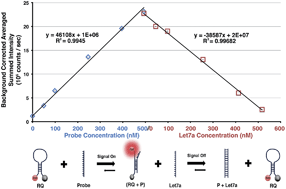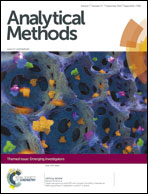Fluorescent microRNA biosensors: a comparison of signal generation to quenching†
Abstract
Many microRNA biosensor platforms use fluorescence signal generation or quenching; however, signal generation is often regarded as the superior method. An argument can be made that if the noise is the same for both methods, then there should be no difference between the two methods. Current literature details the analytical figures of merit (FOM) for transduction and recognition mechanisms that use either signal generation or quenching, but lacks a direct comparison using the same fluorescent reporter molecule. Here we provide such a direct comparison. The signal-on and signal-off fluorescence metrics were found to be comparable rather than competitive. We found fluorescence enhancement provides marginal improvements to sensitivity and limits of detection (LOD) over fluorescence quenching. In fact, both transduction mechanisms are capable of picomolar LOD. The role thermodynamics plays on the sensitivity and LOD are discussed. Both signal-on and signal-off gave statistically similar signal-to-noise ratios. Finally, the selectivity of the two recognition mechanisms for miRNA detection will be addressed. In the future, we will use this knowledge to advance highly sensitive and selective in situ microRNA sensors for cell and tissue imaging.

- This article is part of the themed collection: Emerging Investigators

 Please wait while we load your content...
Please wait while we load your content...